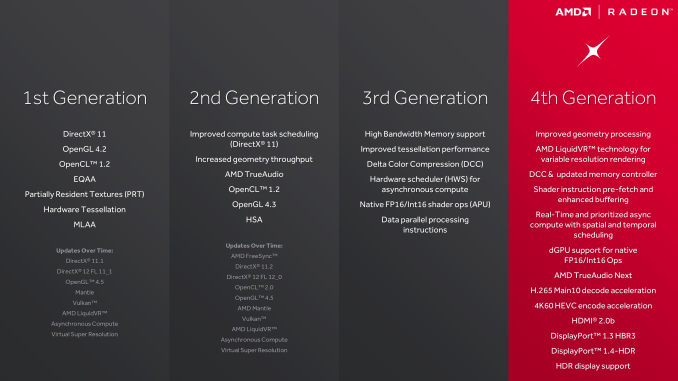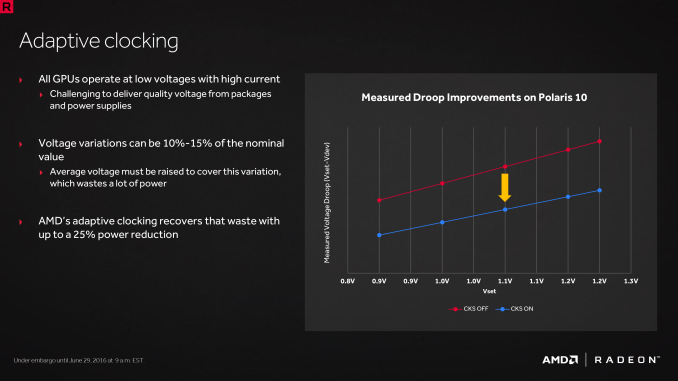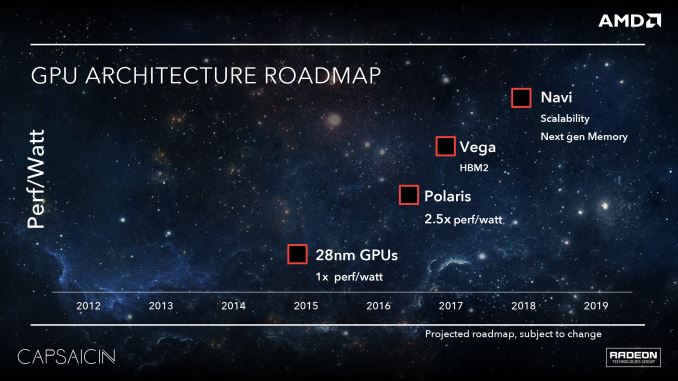The AMD Radeon RX 480 Preview: Polaris Makes Its Mainstream Mark
by Ryan Smith on June 29, 2016 9:00 AM ESTAMD's Path to Polaris
With the benefit of hindsight, I think in reflection that the 28nm generation started out better for AMD than it ended. The first Graphics Core Next card, Radeon HD 7970, had the advantage of launching more than a quarter before NVIDIA’s competing Kepler cards. And while AMD trailed in power efficiency from the start, at least for a time there they could compete for the top spot in the market with products such as the Radeon HD 7970 GHz Edition, before NVIDIA rolled out their largest Kepler GPUs.
However I think where things really went off of the rails for AMD was mid-cycle, in 2014, when NVIDIA unveiled the Maxwell architecture. Kepler was good, but Maxwell was great; NVIDIA further improved their architectural and energy efficiency (at times immensely so), and this put AMD on the back foot for the rest of the generation. AMD had performant parts from the bottom R7 360 right up to the top Fury X, but they were never in a position to catch Maxwell’s efficiency, a quality that proved to resonate with both reviewers and gamers.
The lessons of the 28nm generation were not lost on AMD. Graphics Core Next was a solid architecture and opened the door to AMD in a number of ways, but the Radeon brand does not exist in a vacuum, and it needs to compete with the more successful NVIDIA. At the same time AMD is nothing if not scrappy, and they can surprise us when we least expect it. But sometimes the only way to learn is the hard way, and for AMD I think the latter half of the 28nm generation was for the Radeon Technologies Group learning the hard way.
So what lessons did AMD learn for Polaris? First and foremost, power efficiency matters. It matters quite a lot in fact. Every vendor – be it AMD, Intel, or NVIDIA – will play up their strongest attributes. But power efficiency caught on with consumers, more so than any other “feature” in the 28nm generation. Though its importance in the desktop market is forum argument fodder to this day, power efficiency and overall performance are two sides of the same coin. There are practical limits for how much power can be dissipated in different card form factors, so the greater the efficiency, the greater the performance at a specific form factor. This aspect is even more important in the notebook space, where GPUs are at the mercy of limited cooling and there is a hard ceiling on heat dissipation.
As a result a significant amount of the work that has gone into Polaris has been into improving power efficiency. To be blunt, AMD has to be able to better compete with NVIDIA here, but AMD’s position is more nuanced than simply beating NVIDIA. AMD largely missed the boat on notebooks in the last generation, and they don’t want to repeat their mistakes. At the same time, starting now with an energy efficient architecture means that when they scale up and scale out with bigger and faster chips, they have a solid base to work from, and ultimately, more chances to achieve better performance.
The other lesson AMD learned for Polaris is that market share matters. This is not an end-user problem – AMD’s market share doesn’t change the performance or value of their cards – but we can’t talk about what led to Polaris without addressing it. AMD’s share of the consumer GPU market is about as low as it ever has been; this translates not only into weaker sales, but it undermines AMD’s position as a whole. Consumers are more likely to buy what’s safe, and OEMs aren’t much different, never mind the psychological aspects of the bandwagon effect.
Consequently, with Polaris AMD made the decision to start with the mainstream market and then work up from there, a significant departure from the traditional top-down GPU rollouts. This means developing chips like Polaris 10 and 11 first, targeting mainstream desktops and laptops, and letting the larger enthusiast class GPUs follow. The potential payoff for AMD here is that this is the opposite of what NVIDIA has done, and that means AMD gets to go after the high volume mainstream market first while NVIDIA builds down. Should everything go according to plan, then this gives AMD the opportunity to grow out their market share, and ultimately shore up their business.
As we dive into Polaris, its abilities, and its performance, it’s these two lessons we’ll see crop up time and time again, as these were some of the guiding lessons in Polaris’s design. AMD has taken the lessons of the 28nm generation to heart and have crafted a plan to move forward with the FinFET generation, charting a different, and hopefully more successful path.
Though with this talk of energy efficiency and mainstream GPUs, let’s be clear here: this isn’t AMD’s small die strategy reborn. AMD has already announced their Vega architecture, which will follow up on the work done by Polaris. Though not explicitly stated by AMD, it has been strongly hinted at that these are the higher performance chips that in past generations we’d see AMD launch with first, offering performance features such as HBM2. AMD will have to live with the fact that for the near future they have no shot at the performance crown – and the halo effect that comes with it – but with any luck, it will put AMD in a better position to strike at the high-end market once Vega’s time does come.













449 Comments
View All Comments
Peichen - Wednesday, June 29, 2016 - link
Feel like AMD finally caught up with i5-2500K in price, performance and power but the game already moved on a long time ago. That's how AMD's CPU division died isn't it? Always a step or two behind.14nm card with the performance and power of a 2-years old 28nm card. If Nvidia is lazy, a die shrink 970 on 14nm will match 480 and be cheaper to make. The new 1060 will probably be even cheaper for Nvidia to make to maintain profitability.
I am glad there are people still firmly in the AMD camp. I moved to Nvidia over a year ago but we always need someone to make sure Nvidia's mainstream pricing is not over-the-top.
Nickgofly2019 - Wednesday, June 29, 2016 - link
Lmfao this is amazingly disappointing. I had the feeling when they said "VR ready" that it was just going to be around 970 performance, what Nvidia called "VR ready". Newsflash people: 970s have been selling for $260-$300 for about a year now. This "generational" leap from AMD to 16nn was only able to get them to that level of performance and the power consumption of a generation old Nvidia 28nn process that's been selling for <300. Nvidia at this point could just ask sellers to drop their 970 prices to 200 until the 1060/1050 come out and boom they'd be "competing" with this shitty, loud, power hungry for the process card. Nothing's changed, AMD is still largely behind in all aspects, got t hopes up too fast. I suspect the 1060 at $300 will have 980 performance and the 1050 compete with this at $200.DonMiguel85 - Wednesday, June 29, 2016 - link
Chances are the 1060 will be more or less a 1080 chopped in half with a 192-bit bus, so unless they price it at $250 or less I think the RX 480 will still be a much better buy.AntDX316 - Thursday, June 30, 2016 - link
There is some law of why NVidia cannot totally shut out AMD. There was news about a problem with Intel and AMD way way back and AMD was fined or sued for like $1.1B. It was some monopoly agreement or something.fanofanand - Thursday, June 30, 2016 - link
You have it back asswards. Intel was fined for their anti-competitive monopolistic policies.DonMiguel85 - Wednesday, June 29, 2016 - link
GTX 1060 is rumored to come in only 3GB and 6GB flavors with a 192-bit bus and 1280 shaders. Even if it can overclock to around ~2GHz performance will likely be between the 970 and 980. I think this card is still a better buy for the extra 2GB VRAM. Just consumes more power.none12345 - Wednesday, June 29, 2016 - link
I was hoping for a lil bit more performance, but all in all this card beats anything else in its price range by a large margin. I was expecting it to be a bit slower then a 980, but instead its a bit faster then a 970(that bit should grow to a good bit faster in the games just about to be released, or released in the next year, and it probably will be more or less a 980 in those games). If i had $200 to spend, and the 970 dropped another $80 to $200, id still get a 4gb 480 over the 970. But as of today the 970s price is way too high to even be a consideration against the 480.If i didnt get a graphics card in december, id be buying a 480 the second one of the manufactures releases one with an open air cooler and an 8pin power connector(i would wait and not buy the reference, but im patient).
To those complaining that a 480 is only a bit faster then the 970 that released 2 years ago. Well DUH, but then you are comparing a $330 card to a $240 card or a $330 card to a $200 card. The 970 prices are falling like a rock because of the new cards coming out. It will continue to fall in price untill its price/pef matches what is coming out, but again DUH, thats how the market works.... As of right now, checking newegg, the 970 is way too high of a price to even be considered a contender.
KoolAidMan1 - Wednesday, June 29, 2016 - link
One problem is that you really want to spend more on the 8GB model in order to really compete with the GTX 970. Getting comparable performance the the 970 for $200 is great, except that's not what's actually happening.I'm very curious to see what the price and performance on the 1060 end up being.
Teknobug - Wednesday, June 29, 2016 - link
Amazong, a review on an unreleaesd RX 480 over a month old GTX1080?Hrel - Wednesday, June 29, 2016 - link
Looks like AMD has just become the hardware you buy because you literally can't afford something better.I cannot imagine even one scenario in which I wouldn't use Intel and Nvidia to build a computer, hence forth.